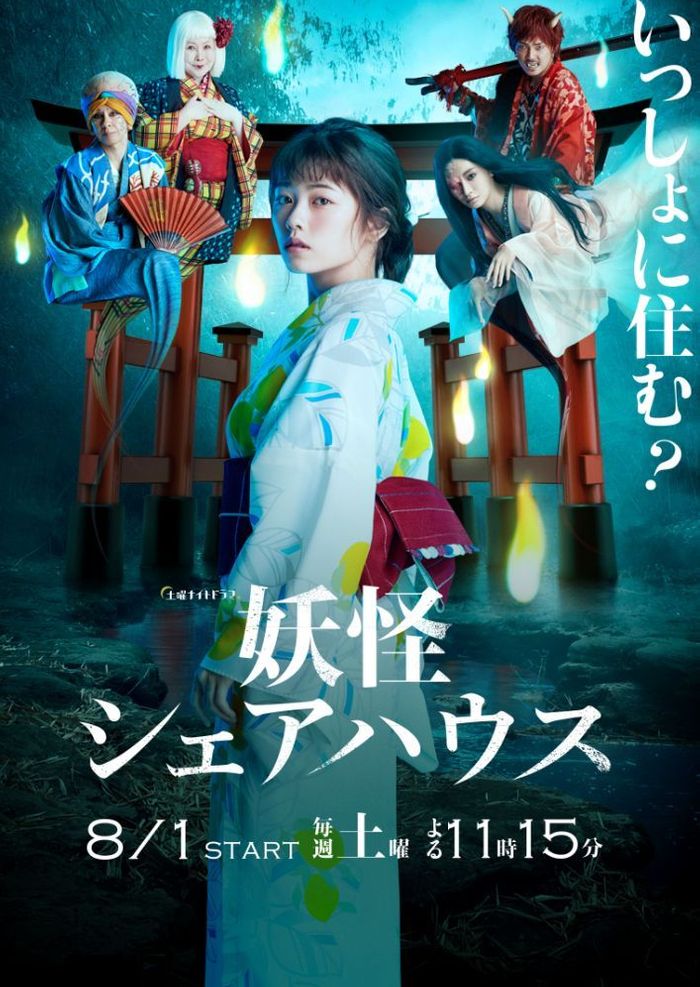
The TV series Monster Share House got high popularity from the very beginning. After the two seasons of this TV series, the movie sequel Yokai Housemate was screened on June 17th, 2022. Many yokai are in the story, their personality and their jobs are related to the Japanese mythology they belonged to. Let me introduce some backstories of the Yokai that are in the first season.

Oiwa from Yotsuya Kaidan

"The Ghost Story of Yotsuya" often serves as a theme for Kabuki performances. Among the characters featured, Oiwa stands out from other Japanese yokai as more of a vengeful spirit lingering in the human realm. It is said that Oiwa's husband, Iemon, poisoned her due to his infidelity. Consuming the poison, Oiwa's face half rotted away, and she died in agony. At the story's end, Oiwa returns to exact revenge on Iemon, sealing the fate of his household for generations to come.
However, in reality, before this story became widely circulated, there was indeed a figure named Oiwa, who was quite different from the folk horror tale. Oiwa, also known as O-Iwa-sama, and her husband, Iemon, had a harmonious marriage and worked together to revitalize the Tamamo family. Oiwa frequently visited the Inari Shrine within the Tamamo estate, and during the Meiji era, this shrine was officially named "Oiwa Inari Tamamo Shrine." Even to this day, it remains not only a shrine frequently visited by Kabuki theater troupes but also a temple where many pray for prosperous businesses and family safety.
Shuten-dōji

Shuten Doji is a really famous Japanese yokai and often appears in many different games. With the nine-tailed fox, OtakeMaru is known as Japan's three famous monsters. Based on the myth, Shuten Doji’s mother took 16 months to have him. When Shuten doji was born, he always had hair and teeth and even had incredible physical strength. However, Shuten doji was shunned by others in the village because of his differences. After he was abandoned by his mother, Shuten doji became an oni (Japanese monster). After becoming an oni, he loves to drink, and when there are visitors, he would be disguised as a handsome young man.
Nurarihyon

What would you do if you saw a strange old man walk into your home? Nurarihyon is an old man wearing Japanese traditional clothing based on Japanese folktales. When you are busy, he would walk into your house leisurely, have a cup of tea, and even use the pipe. Different from the Japanese God that would project your house, Nurarihyon would stay in a place for a long, he would walk around to different houses.
Zashiki-warashi

The origins of Zashiki Warashi can vary based on the region. Some of them said the daughter of a woman is trying to find herbs to heal her mother’s illness but falls down a cliff while trying to find the herbs by accident. Another myth is about a family that cannot feed all their children so they killed some of the children with a stone mortar. Zashiki Warashi comes from those children’s spirits. Because Zashiki Warashi often appears at houses so there are people who believe that Zashiki Warashi comes from the spirit of the construction workers that are dead during the construction.
Even though the origin of the story can no longer be found, Zashiki Warashi is still widely known as the spirit that would protect your house. Some say Zashiki Warashi looks like a little girl with dark skin and short hair and likes to trick people and play with children. She can bring luck to the house. Ryokufuso in Iwate prefecture is famous for being able to see Zashiki Warashi.
Amabie

People started to know about Amabie because of the pandemic of covid-19. Amabile is a mermaid/merman-like yokai that lives at the bottom of the ocean. It has long hair, a bird's beak, a body of a fish, and 3 legs. According to the legend, Amabie appeared on the coast of the Kumamoto region in the Edo period. Amabile told people that there will be a bumper crop but the disease is coming as well. If you draw Amabie’s look you will be protected. After that, there is an epidemic disease in fact. Thus the legend of Amabie started to be known by man.
Kappa

There are so many kinds of Kappa’s origin. The looks of Kappa can also vary differently based on the region. Some people believe that Kappa is the messenger of the river god. There are people who believe that Kappa is a child's body that starves to death because the appearance and size of Kappa are like children but with a bold head and green smelly skin. Even though we couldn’t determine the true origin of Kappa, you can find information about Kappa all around Japan! Japanese people believe that Kappa would trick you, so they are always used to warning children not to play in the river.
Tengu

Tengu can be separated into two different types: Daitengu with red faces and long red noses, holding a magical feather fan. Kotengu with a bird beak and holding a sword in his hand. Both types of Tengu have wings. In the Japanese folktale, Tengu can protect people from disaster and bring people luck. Now people pray to Tengu and treat them as the god of mountains. The most famous is Mount Takao.






























